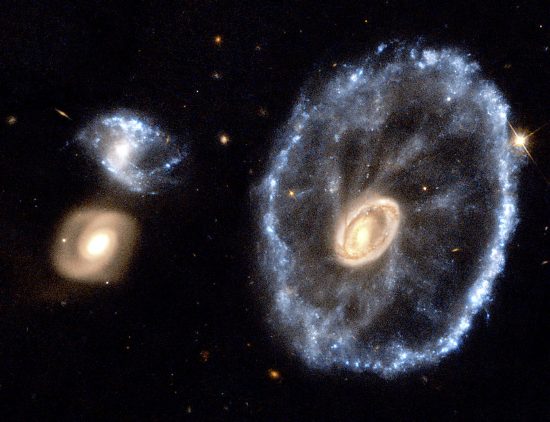
Jan 24, 2019
What forms galactic disks?
Observations by the Sloan Digital Sky Survey (SDSS) indicate that a torus of stars surrounds the Milky Way at a distance of 120,000 light-years. The Milky Way’s stellar population was previously estimated to be about 200 billion stars contained in the spiral arms and nucleus. The additional population of stars in the ring puts that number at around one trillion stars.
The ring of stars is conventionally thought to be the remains of a collision between the Milky Way and a dwarf galaxy billions of years ago. How a “collision” between two structures that are almost nothing but empty space leaves coherent formations behind is a mystery. What drives the birth of “young” blue stars, along with a swarm of globular clusters similar to those in other galactic rings, is also mysterious.
Consensus viewpoints are missing important factors right out of the gate when they assume that galaxies are gravity-based structures that obey kinetic notions of mechanics and momentum. However, they are not “whirlpools of stars” that depend on gravity. Galaxies are electrically active agglomerations in which each star is the locus of charge flow. Electricity flowing through dusty plasma is responsible for the births of stars and galaxies. Such flows of electricity are commonly called Birkeland currents, after their discoverer, Kristian Birkeland.
Electricity moves out of a galaxy’s polar axis and then returns to the central plasmoid through its spiral arms. Even in elliptical and other galactic shapes, barred-spirals are seen embedded inside their disks. There are circuits across galactic disks, receiving power from Birkeland currents connecting them with the rest of the Universe. Presumably, strands of magnetically confined electric filaments are transmitting power from one end of space to the other. Instead of gravity, as intergalactic Birkeland currents move through galaxies they generate toroidal particle beams, which energize rings of stars at the disk edges.
Birkeland currents form helices as they twist around one another. Cross sections through the helices in laboratory experiments reveal familiar barred-spiral shapes. Since galaxies are most likely electrical in nature, electromagnetic forces act on them with such power that kinetic forces, like collisions, can be ignored when modeling their shapes and behaviors.
In the image at the top of the page, the Cartwheel galaxy (ESO 350-40) reveals an extreme example of filaments connecting a galaxy’s core with its ring. Galactic haloes, seen in the light of electrical theories, can mean an entirely new way of seeing evolution in the Universe. Stellar haloes are actually examples of a dense plasma focus penumbra. Images from experiments using a “plasma gun” offer a direct analogue to the “pinch zones” surrounding an electric discharge from the Cartwheel galaxy.
Stephen Smith












